Stunning interior lighting design in a living room combines layered light sources for depth and warmth. Begin with ambient lighting to set the mood, complemented by task and accent lighting to focus on key areas. Select fixtures that fit the room’s scale and utilize dimmers for versatile brightness. Choose light bulbs with ideal characteristics for comfort, while maximizing natural light through strategic placements. Harmonize designs for a cohesive look. Explore more strategies to elevate the ambiance creatively.
Key Takeaways
- Layer your light sources by combining ambient, task, accent, and decorative lighting for a balanced and inviting atmosphere.
- Choose fixtures that match the scale of your room and design to create harmony and visual weight balance.
- Utilize dimmers and smart lighting technology to customize brightness and energy efficiency for various activities.
- Enhance natural light through reflective surfaces and appropriate window treatments while maintaining a cohesive design language across fixtures.
- Regularly maintain and reassess your lighting setup, ensuring optimal performance and aesthetic appeal with clean fixtures and suitable bulbs.
Layer Your Light Sources Effectively
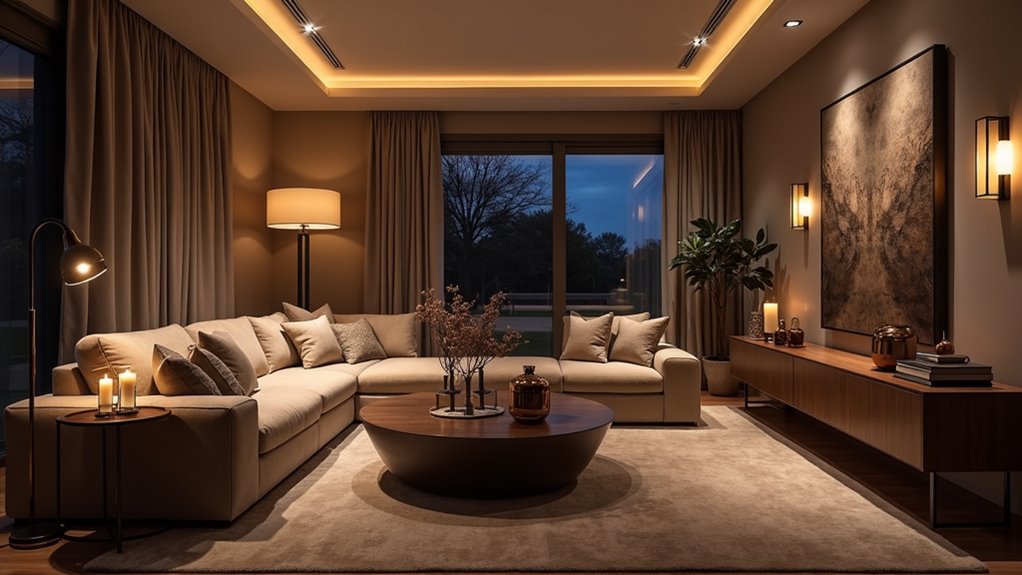
To create a captivating and functional living space, one must master the art of layering light sources.
Ambient light sets the foundational mood, illuminating the room with an inviting glow from chandeliers or recessed fixtures. This foundational layer acts as a canvas for accent and task lights, providing a holistic approach to illumination. Incorporating a unifying element, such as finish or shape, can further enhance the cohesive appearance of your lighting design.
Task light, positioned strategically near seating or workspaces, enhances visibility for focused activities like reading or hobbies, ensuring comfort without strain.
Accent light introduces visual interest, spotlighting art or architectural features, while decorative lighting adds personality through artistic fixtures.
Effective light placement at varying heights fosters a balanced design atmosphere, transforming a flat space into a dynamic environment.
Embracing light layering promotes flexible lighting, allowing the living room to adapt effortlessly to daily activities and varied moods, enhancing overall enjoyment and comfort.
Select the Right Fixtures and Scale

Choosing the right fixtures and scale can transform a living room into a harmonious blend of functionality and style.
Fixture selection begins with understanding the room’s dimensions and the type of ambience desired. Chandeliers add sophistication to high ceilings, while pendants enhance cozy corners. For lower ceilings, flush and semi-flush mounts are ideal, ensuring ample clearance without sacrificing design.
Scale considerations are crucial; the diameter of a central fixture should match room dimensions—adding lengths and widths for an ideal measurement. For table lighting, fixtures must be proportionally smaller than the table for balance.
Lastly, visual weight matters—clear glass may appear lighter, while colored glass provides depth, shaping an inviting atmosphere.
Strategically Place Your Lighting
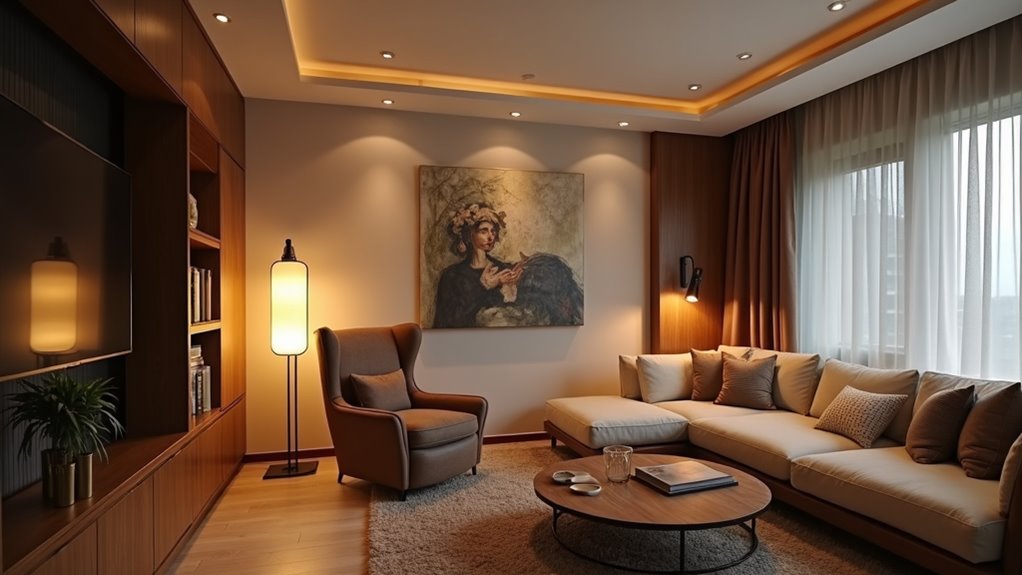
In the realm of lighting design, the strategic arrangement of light sources can transform a living room.
By varying heights, one can draw the eye to key features while simultaneously avoiding distracting glare from overhead fixtures.
This thoughtful placement not only enhances the room’s aesthetic but also fosters a harmonious balance of illumination throughout the space.
Varying Heights Arrangement
When arranging lighting within a space, varying heights can dramatically transform the visual landscape, creating a rich interplay of light and shadow. A well-thought-out pendant arrangement, where lights hang at different levels, serves as a stunning focal point that draws the eyes upward.
This method not only enhances an open atmosphere but also prevents monotony. Layered lighting further enriches the experience, combining ambient illumination from overhead sources with mid-level wall sconces and low-level uplights.
Such arrangements define the room’s dynamics, crafting inviting spaces perfect for various activities. By strategically layering fixtures, any living room can achieve a cozy ambiance while effectively distributing light, ensuring every corner shines beautifully without harsh shadows.
Highlight Key Features
Strategically placing lighting not only highlights the key features of a space but also elevates its overall aesthetic.
Thoughtful artwork illumination can transform a room; using picture lights or adjustable track lighting ensures a dynamic emphasis on cherished pieces.
Recessed spotlights angled near the wall enhance visual depth, while wall-mounted sconces create that sought-after gallery ambiance.
For architectural accentuation, uplighting at the base of columns accentuates height and texture, whereas downlighting reveals the beautiful intricacies of textured surfaces.
Wall grazing showcases materials like brick or stone with striking detail, while LED strips incorporated in shelves add modern elegance.
These techniques collectively work to elevate the intrinsic charm of a living room, guiding the eye towards its most captivating features.
Avoid Overhead Glare
While creating a harmonious lighting environment, it is essential to minimize overhead glare, which can detract from the room’s comfort and functionality.
Strategically placing overhead lighting and utilizing fixture angles effectively helps achieve glare reduction. Incorporating shades or diffusers softens light, allowing it to spread evenly while preventing harsh beams.
Indirect illumination, such as cove lighting or uplighting, bounces light off ceilings, resulting in a warm glow that reduces shadows. Careful positioning of fixtures, avoiding direct lines of sight with screens, ensures an inviting atmosphere.
Utilize Dimmers and Smart Lighting
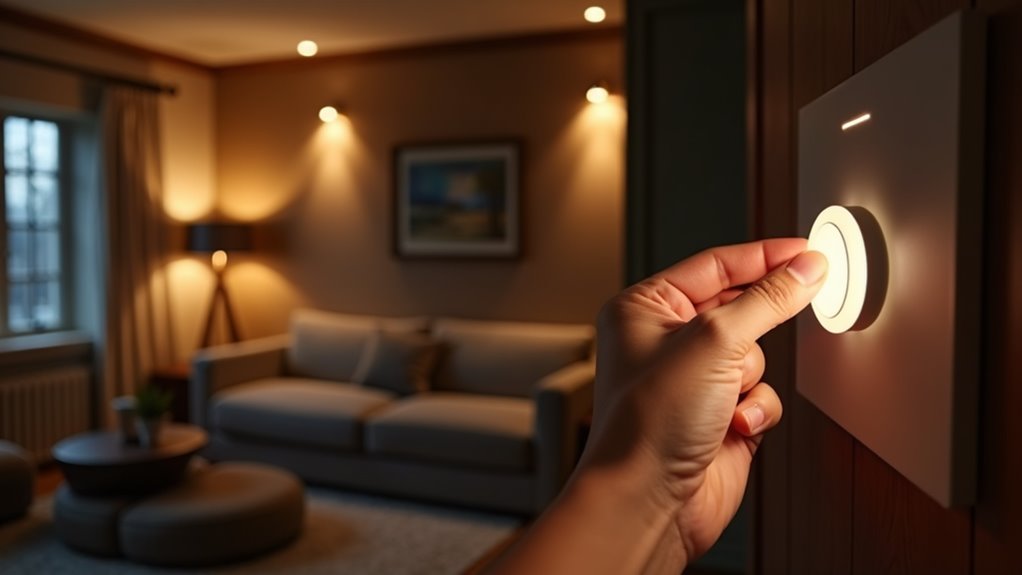
In the realm of interior lighting design, adjustable brightness control serves as a vital tool for shaping the ambiance of a space.
With smart lighting innovations, homeowners can effortlessly switch between vibrant energy for daytime activities and soft hues that encourage relaxation at night.
Adjustable Brightness Control
How can the atmosphere of a room be transformed with a simple twist or touch? Adjustable brightness control offers the key to creating the perfect ambiance in a living room.
By utilizing dimmers, homeowners can easily make ambient adjustments, shifting from vibrant light for lively gatherings to soft, warm tones for cozy evenings.
Different activities—like reading or watching a movie—benefit from tailored brightness preferences, enhancing comfort and reducing eye strain.
Moreover, dimming lights can extend bulb lifespan and contribute to energy efficiency, leading to lower bills.
Smart Lighting Innovations
Smart lighting innovations have revolutionized the way homeowners experience and control their living spaces. With the rise of smart bulb integration, energy efficiency has soared, allowing users to reduce consumption by up to 75%.
This shift not only translates into annual savings of around $225 but also enhances longevity, with smart LED bulbs lasting 15 to 30 years.
Lighting automation trends, such as motion sensors and scheduling, enable lights to illuminate only when necessary, minimizing waste. Control features like remote access, voice command integration, and geofencing further streamline the experience, making it intuitive and convenient.
Homeowners can create customized scenes that cater to various activities, ensuring the perfect ambiance while optimizing energy use.
Mood Enhancement Techniques
While many may overlook the importance of lighting in shaping atmosphere, effective mood enhancement techniques involving dimmers and smart lighting can transform a space dramatically.
Dimmers provide mood-boosting flexibility, allowing users to adjust brightness levels, creating inviting ambiances that can shift from cozy to vibrant. Softer lighting promotes relaxation, while brighter settings can increase energy and focus.
Smart lighting elevates this experience further with customizable color temperatures, mimicking natural light cycles to support emotional lighting needs. Personalized scenes for activities, from “movie night” to “relax mode,” enhance engagement.
With voice or app control, adjusting light becomes effortless, ensuring an environment that not only appeals visually but also nurtures well-being and emotional balance.
Choose the Ideal Bulb Characteristics
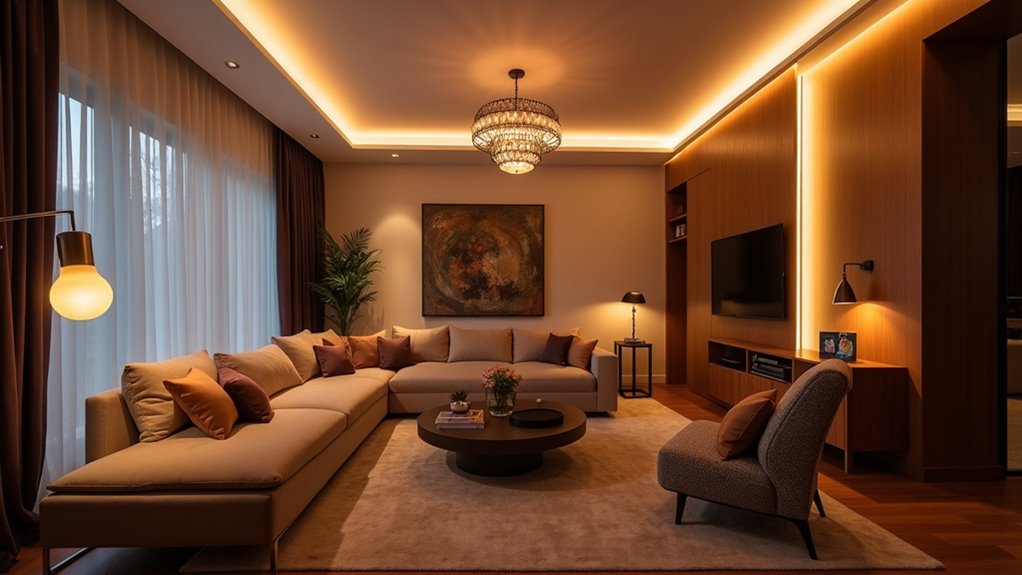
Selecting the ideal bulb characteristics can transform a living space from mundane to magnificent. Understanding color temperature, brightness, and color rendering index ensures optimal bulb efficiency and light quality. For living rooms, warm white hues around 2700K to 3000K create an inviting atmosphere, while a well-chosen lumen output of 1500 to 3000 lumens will provide adequate brightness. Additionally, a CRI of 90 or higher guarantees that colors appear vibrant and true.
| Characteristic | Ideal Range | Impact |
|---|---|---|
| Color Temperature | 2700K – 3000K | Cozy ambiance |
| Brightness (Lumens) | 1500 – 3000 lm | Sufficient illumination |
| Color Rendering Index | 90 or higher | Accurate color representation |
Maximize Natural Light in Your Space
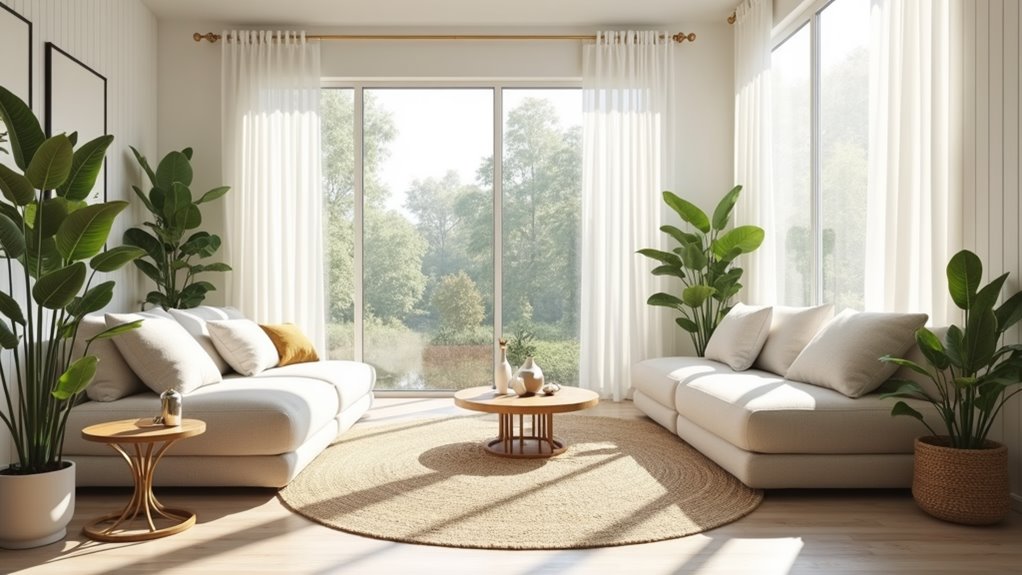
Achieving the right balance of artificial and natural light can elevate a room’s ambiance, infusing it with life and warmth.
To maximize natural illumination, opt for strategic window treatments like light-filtering sheer curtains or bottom-up shades, ensuring privacy while allowing sunlight to flow.
Incorporate reflective surfaces such as mirrors and glossy furniture to amplify brightness and create an expansive feel.
Choose light colors for walls and furnishings; shades of white, beige, or soft pastels will enhance the airy atmosphere.
Careful furniture arrangement is crucial; avoid obstructions in front of windows and maintain clear pathways for light.
Additionally, consider architectural elements like larger windows or skylights and implement maintenance tips to keep glass surfaces pristine, ensuring the best light quality into the space.
Create a Cohesive Design Language
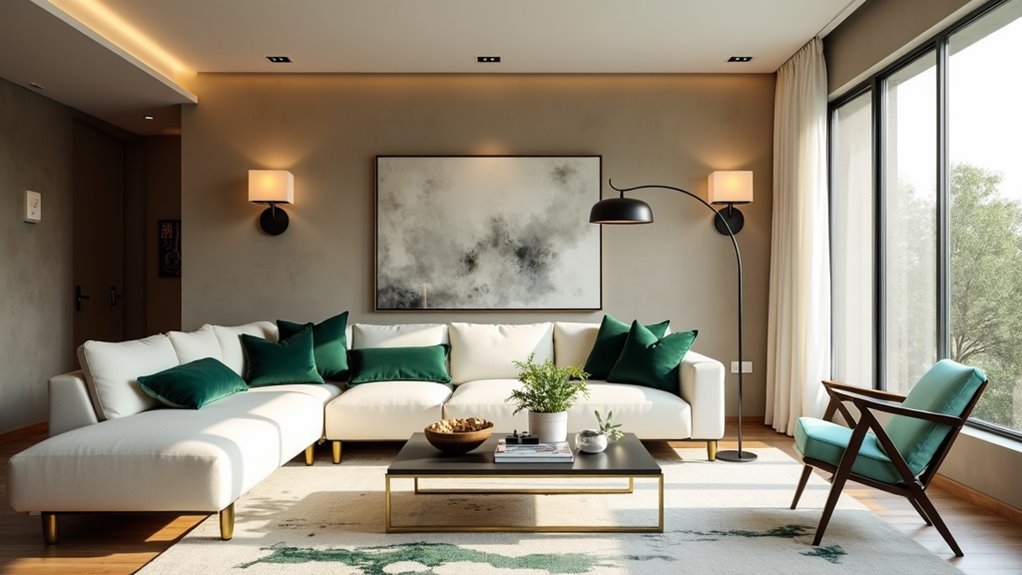
Creating a cohesive design language in interior lighting involves harmonizing various elements to establish a unified aesthetic. This begins with unifying lighting styles; fixtures should relate in shape, color, or finish, promoting cohesive aesthetics.
Incorporating a consistent finish, such as brushed nickel or brass, further enhances unity throughout the living room. Additionally, harmonizing color temperature—ideally warm light—brings an inviting feel and promotes lighting harmony.
Layering ambient, task, and accent lighting is essential; each layer should interconnect seamlessly to support the overall design.
Finally, aligning lighting choices with the room’s decor style and color palette fosters a balanced look, allowing each element to resonate in an orchestrated visual symphony that transforms the living space into a cohesive sanctuary.


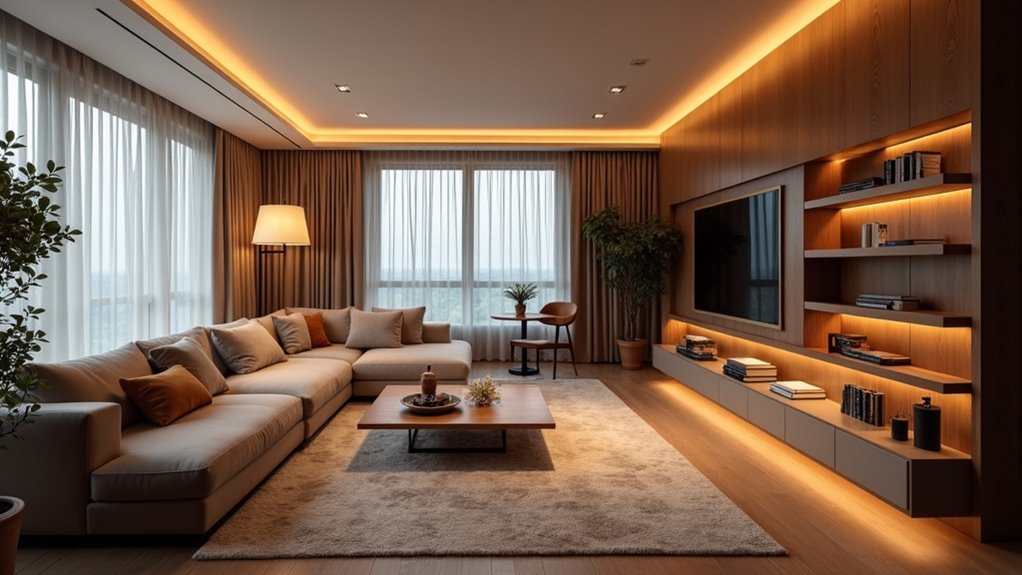
Bài viết cùng chủ đề:
10 Essential Living Room Lighting Trends for 2025
Top 5 Living Room Track Lighting Fixtures for Modern Homes
7 Tips for Creating Stunning Living Room Cove Lighting Designs
3 Brilliant Ideas for Living Room Floor Lighting
7 Tips for Perfect Living Room Ceiling Recessed Lighting
10 Brilliant Living Room Overhead Lighting Ideas